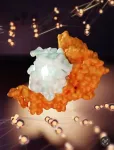Recent developments include promising results from combining immunotherapy with radiation for non-small cell lung cancer (NSCLC), a novel combination therapy for secondary and treatment-resistant blood cancers, understanding the prognostic value of splicing factor gene mutations in AML, an approach to overcoming treatment resistance in HR-positive/HER2-negative metastatic breast cancer, a new treatment strategy for metastatic appendix cancer, improved survival outcomes for young adults with multiple myeloma, a preventive treatment to lessen toxicities from chimeric antigen receptor (CAR) T cell therapy, and the use of artificial intelligence to improve prognostic models for patients with cancer.
Read this press release on the MD Anderson newsroom.
Immunotherapy plus targeted radiation improved lung cancer outcomes compared to radiation alone
Standard treatment for inoperable early stage non-small cell lung cancer (NSCLC) is a form of targeted radiation called stereotactic ablative radiotherapy (SABR), but relapses remain common. Results from a Phase II randomized study, led by Joe Chang, M.D., Ph.D., and John Heymach, M.D., Ph.D., found combining SABR with immunotherapy (nivolumab) significantly improved the outcomes of early-stage NSCLC patients compared to those who received SABR alone. At a median 33-month follow up across 156 patients, the four-year, event-free survival rate was 77% in the combined treatment group compared to 53% with SABR only. The risk of recurrence was reduced by 62% in patients who received the combination. Some patients in the combination group experienced manageable immunological adverse events. The results suggest the therapeutic potential of combining immunotherapy with SABR, but further studies are needed to confirm possible benefits. in The Lancet.
Triplet combination shows promising activity for patients with AML, MDS or CMML
Patients with secondary acute myeloid leukemia (AML) that develops after receiving chemotherapy or radiation therapy usually have high-risk molecular features that lead to a poor prognosis. There are also limited treatment options for patients with myelodysplastic syndromes (MDS) or chronic myelomonocytic leukemia (CMML) after failure of hypomethylating agents (HMAs). Pevonedistat, a first-in-class NEDD8 inhibitor, has demonstrated clinical benefit in both settings and synergizes with both azacitidine and venetoclax. Therefore, Nicholas Short, M.D., and his colleagues designed a Phase I/II trial to evaluate the triplet combination of azacitidine, venetoclax and pevonedistat in patients with secondary AML and with HMA-resistant MDS or CMML. In patients with very high-risk secondary AML, the combination resulted in a response rate of 66%; in patients with MDS or CMML after HMA failure, the response rate was 75%. Based on these promising results, researchers now are conducting a randomized Phase III study of azacitidine and venetoclax, with or without pevonedistat, in older adults with newly diagnosed AML. Learn more in the Journal of Hematology & Oncology.
Venetoclax-based therapy improves outcomes in patients with AML and mutations in splicing factor genes
Mutations in specific splicing factor genes are associated with an adverse risk for acute myeloid leukemia (AML) in certain patients, but the prognostic impact of these mutations has been drawn primarily from younger patients treated with intensive therapy. To evaluate the impact of these mutations in a broader population, researchers led by Jayastu Senapati, M.D., and Courtney DiNardo, M.D., evaluated outcomes in 994 older patients with newly diagnosed AML, including 266 with splicing factor gene mutations. While these mutations were enriched in older patients and in those with secondary AML, their presence did not affect the odds of response to therapy. The study found adding venetoclax to low-intensity or intensive therapies negated any association of these mutations with poor prognosis. The researchers suggest newer prognostic models, which consider additional factors such as the use of venetoclax, are warranted. Learn more in Blood.
Abemaciclib is effective in palbociclib-resistant HR-positive metastatic breast cancers
The hormone receptor (HR)-positive, HER2-negative subtype of breast cancer accounts for about 70% of patients, while initial treatment for metastatic disease usually includes CDK4/6 inhibitors palbociclib, ribociclib or abemaciclib in combination with endocrine therapy. However, many patients eventually develop treatment resistance, highlighting a need to understand the mechanisms of drug resistance in order to improve clinical outcomes. Researchers led by Khandan Keyomarsi, Ph.D., used multi-omic DNA, RNA and protein analyses in pre-clinical models to demonstrate that palbociclib and abemaciclib act on different biological pathways and that cancer cells can exhibit distinct profiles that sensitize them to different CDK4/6 inhibitors. Analyzing outcomes of patients with HR-positive/HER2-negative metastatic breast cancer showed abemaciclib after palbociclib had meaningful clinical benefit, highlighting the potential use of sequential abemaciclib as a feasible approach for improving patient outcomes following palbociclib resistance. Learn more in Cancer Research.
Preclinical study shows intraperitoneal paclitaxel is safe and effective in appendix cancer
Appendix cancer is a rare gastrointestinal cancer, and the lack of preclinical models has resulted in limited available treatment options. Additionally, the current standard of care – surgery and heated intraperitoneal (IP) chemotherapy – is not appropriate for patients with a large tumor burden. These patients historically have been treated with chemotherapy intended for colorectal cancer, which is ineffective for many patients and highlights a critical unmet need. Given these tumors are in the peritoneal space, researchers led by John Paul Shen, M.D., hypothesized that IP paclitaxel, which is safe and effective in other cancers, would also be effective in appendix cancer. In three different lab models of appendix cancer, weekly IP paclitaxel significantly reduced tumor growth and had fewer side effects than intravenous chemotherapy. This study demonstrates the promising therapeutic potential of IP paclitaxel. Based on these results, Beth Helmink, M.D., PhD., Michael White, M.D., and Shen will evaluate this approach in an upcoming clinical trial for patients with metastatic appendix cancer. Learn more in Cancer Research.
Simultaneous immunotherapy and brain radiation show promise in lung cancer patients with brain metastases
Approximately 20% of patients diagnosed with non-small cell lung cancer (NSCLC) will develop brain metastases, which typically are treated with radiation therapy and surgery. According to results of a new non-randomized Phase I/II trial, combining the immunotherapy drugs ipilimumab and nivolumab with stereotactic body radiotherapy (SRS) was well tolerated in NSCLC patients with brain metastases. Researchers led by Mehmet Altan, M.D., and Jing Li, M.D., Ph.D., evaluated 13 patients who received ipilimumab and nivolumab with SRS and found it was safe with mostly manageable side effects. The estimated four-month intracranial progression-free survival rate was 70.7%. Only one serious adverse reaction was attributed to the combination treatment. The findings suggest the combination therapy could be a promising option for these patients, but further research is needed to assess the efficacy and safety of whole-brain radiotherapy with immunotherapy. Learn more in the Journal for ImmunoTherapy of Cancer.
Survival outcomes in younger adults with newly diagnosed multiple myeloma have significantly improved over the last decade
According to results of a new study led by Oren Pasvolsky, M.D., young adults with newly diagnosed multiple myeloma who received an up-front autologous stem cell transplant had a median progression free survival (PFS) of approximately three and a half years and a median overall survival (OS) of 12 years. Researchers analyzed data from 117 patients with a median age of 37 years at transplant. Patients who received transplants after 2010 had longer PFS and OS compared to those transplanted before 2010. Researchers attribute these improvements to the introduction of novel agents in induction regimens and to widespread use of post-transplant maintenance since 2010. Prior to transplant, 10% of patients achieved a complete response and 44% achieved at least a very good partial response. After transplant and maintenance therapies, these improved to 56% and 77%, respectively. Depth of response following transplant was a key predictor of survival. Learn more in the British Journal of Haematology.
Anakinra can be safely administered in LBCL patients treated with axi-cel to manage CRS and ICANS
Between 90-95% of patients with relapsed and/or refractory large B-cell lymphoma that are treated with axicabtagene ciloleucel (axi-cel) develop cytokine release syndrome (CRS), while 60-64% of patients develop immune effector cell-associated neurotoxicity syndrome (ICANS). Corticosteroids, the main current treatment option, can lead to a negative impact of the CAR T-cell function. In a Phase I study, researchers led by Paolo Strati, M.D., evaluated the safety and tolerability of prophylactic anakinra, an IL-1 receptor, after axi-cel infusion to reduce the risk of CRS and ICANS in patients. Patients experienced less frequent ICANS of any grade (35% vs. 60%) and lower use and duration of treatment for management of ICANS. At a median follow-up of 12 months, the response rate was 65%, the one-year progression-free survival rate was 53%, and the one-year overall survival rate was 79%. Learn more in Blood Advances.
Swarm intelligence improves survival models
Artificial intelligence continues to improve prognostic models based on radiomics features for cancer patients, but one limiting factor involves the difficulty of incorporating the large number of individual variables in patients. A new platform called SwarmDeepSurv, developed by Jia Wu, Ph.D., and colleagues, aims to improve on current methods by incorporating swarm intelligence algorithms, which allow the model to pick the information it chooses as most important and to ignore irrelevant or redundant information. The model not only outperformed current survival models, but it also better stratified patients, which could potentially lead to more accurate and personalized treatment recommendations. Interestingly, the features it selected were largely different from existing algorithms. This platform also has the potential to incorporate additional clinical and genomic information beyond radiomics features. Learn more in Patterns.
Recent awards and honors
Bissan Al-Lazikani, Ph.D., professor of Genomic Medicine, was inducted into the 2023 Class of the International Society for Computational Biology (ISCB) Distinguished Fellows. In case you missed it
Read below to catch up on recent MD Anderson press releases.
Howard and Susan Elias make $16.25 million gift to fund cancer neuroscience research at MD Anderson New single-cell study provides novel insights into gastric cancer Blood test aids in predicting lung cancer mortality risk Largest-ever atlas of normal breast cells brings unprecedented insights into mammary biology
– 30 –
END




